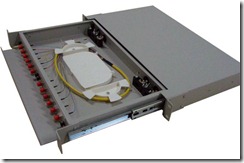Fiber Optic Patch Panel – How to Choose and How to Install
You can get Rack Mount Fiber Optic Patch Panel or Wall Mount Fiber Optic Patch Panel from Fiber Optics For Sale Co.
>> What is a fiber optic patch panel?
Fiber optic patch panel is also called fiber distribution panel. Its main function is to terminate the fiber optic cable and provide connection access to the cable’s individual fibers. Fiber patch panels are termination units, which are designed to provide a secure, organized chamber for housing connectors and splice units.
Fiber patch panels are available in rack mounted or wall mounted and are usually placed near terminating equipment (within patch cable reach). Both types can house, organize, manage and protect fiber optic cable, splices and connectors. Rack mount panels also come in flat and angled versions (as shown in the picture below).
Rack Mount Fiber Optic Patch Panel
Wall Mount Fiber Optic Patch Panel
Fiber patch panels can accommodate fiber adapter panels (also called connector panels), associated trunk cables, connectors, patch cords, and usually include integral cable management.
Using fiber patch cables, individual cable fibers can be cross-connected, connected to a lightwave equipment, or tested at the patch panel. It also allows for labeling of the cable’s individual fibers and a link demarcation point.
>> Construction of a fiber patch panel
The typical termination unit consists of the following components:
- Enclosed chamber – This can be a mountable wall or equipment equipment rack
- Coupler panels (adapter panels) – These hold the connector couplers
- The connector couplers (the connector adapters)
- Splice tray – Organizes and secures splice modules
The patch panel is designed with two compartments: one which contains the bulkhead receptacles or adapters, and the second which is used for splice tray and excess fiber storage. Patch cable management trays are optional for some patch panels and make possible the neat storage of excessive patch cable lengths.
The patch panel’s bulkhead panel contains the adapter (receptacle and barrow). The adapter allows the cable’s fiber connector to mate with the appropriate patch cable connector. It provides a low optical loss connection over many connector matings.
>> Fiber termination in the patch panel
Fiber optic cable can be terminated in a patch panel using both pigtail or field-installable connector fiber termination techniques. The pigtail approach requires that a splice be made and a splice tray be used in the patch panel. The pigtail approach provides the best quality connection and is usually the quickest.
Fiber Optic Pigtail
Note: Fiber optic cable’s minimum bending radius should always be observed when terminating cable at fiber optic patch panels
The second approach uses field-installable connector. The idea is field installing a fiber connector (may it be SC, ST, FC, LC, etc) directly onto the cable’s individual fibers. Typically, you start with a 250um bare fiber, and have to install and polish the connector directly onto the fiber. Special care must be taken in breaking out and protecting the bare fiber.
Corning Unicam Field-Installable Connector
The field-installable connector approach usually takes longer than splicing but does not require a splice or splice tray to be mounted in the patch panel. This reduces material costs and allows for a smaller patch panel to be used. Also the connector loss and quality may not be as good as factory-purchased pigtails. The approach is often used when terminating a tight-buffered cable.





